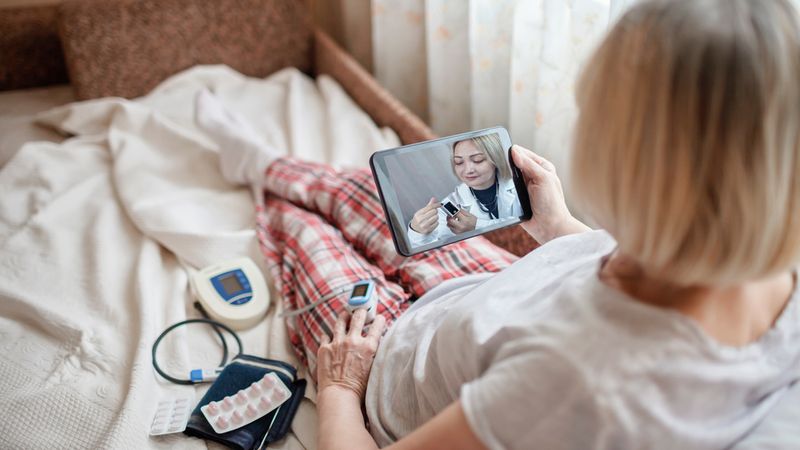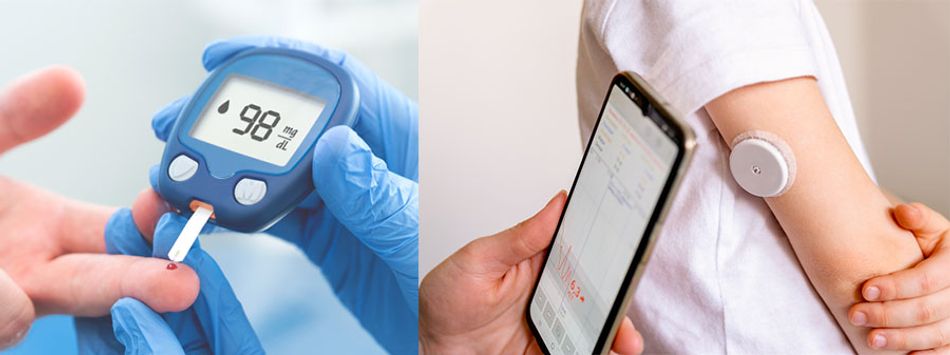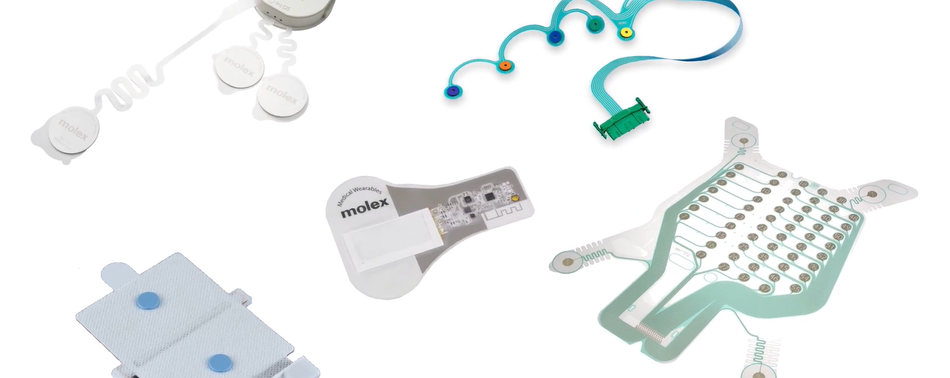Enabling Early Diagnosis and Better Postoperative Care with Remote Health Monitoring Devices
Article #7 of Improving Lives with Digital Healthcare Series: Real-time monitoring of multiple physiological health parameters can be an effective way of preventing and early diagnosis of several diseases.
This is the seventh article in an 8-part series featuring articles on Improving Lives with Digital Healthcare. The series focuses on electronic systems that enable innovation in the healthcare industry. This series is sponsored by Mouser Electronics. Through the sponsorship, Mouser Electronics shares its passion for technologies that enable smarter and connected applications.
Chronic lifestyle diseases (including cardiovascular diseases, cancers, respiratory diseases, diabetes, and more) account for over 41 million deaths annually - equivalent to 71% of all deaths globally.[1] In such a situation, being aware of personal health by monitoring body functions and physiological parameters can help patients and doctors deal with such conditions more effectively.
In this article, we explain the role of wearable devices and their enabling technologies in revolutionizing continuous health monitoring. We’ll consider the example of heart functioning and sugar level monitoring devices to explain how wearables can help with the early diagnosis of common diseases.
Looking Beyond Home Remedies
It is common for people to experience headaches, runny nose, sore throat, and cough anytime during the year. To regain health, they turn to home remedies such as staying hydrated, having fruits, honey, a handful of vitamins, dietary supplements, and other comforting products. They try out different concoctions to combat the symptoms. This medical approach is based upon tradition, folklore, and readily available products at home.
But what if technology provided us with the information to understand our bodies and plan treatments in a better way, to boost our recovery? It would enable us to monitor various physiological parameters and detect if anything is wrong with our bodies. This is precisely the goal of connected health and digital healthcare. The next few sections will look at how connected health assists in patient monitoring.
Connected Health Senses Exactly What’s Going On
Patient monitoring has two major roles to play in healthcare. As a preventive measure, it is used for early diagnosis of the underlying disease or ailment creating symptoms in the patient; as a corrective measure, it is crucial to understand how the patient’s body responds to therapies to mitigate or repair the effects of a disease or other physical ailments.
Devices such as wearable biosensors make it possible for users and healthcare professionals to monitor a wide variety of data points, including vital signs, step counts, and body posture—all in a low-cost, easy-to-use, disposable form.
Improved Consumer Wearables for Monitoring Heart Functioning
Electrocardiography (ECG) is a method to test the heart’s functioning with electrical signals. The idea of tracking heartbeats has been around since the 18th century, but the real turning point in the world of cardiography came in the early 20th century when Willem Einthoven, a Dutch doctor, came up with the first practical ECG.[2] The device was large in size and weighed 600 pounds. The decades that followed saw the refinement of the device led by the contributions of various distinguished researchers. ECGs got smaller, better, and more affordable as digital technologies took over the world.
Today, ECG has begun to blur the lines between wearable devices and the traditional “on-cart” machines (Fig. 1). In recent years, device technologies and software algorithms have allowed the development of on-patient ECG devices that continuously monitor the patient’s heart condition and often predict heart issues before they become fatal. Contemporary fitness trackers and smartwatches like the ones made by Apple are excellent examples of how wearables can help in the early detection of several diseases.
As these devices continue to advance, patient comfort will increase. ECG is poised to take advantage of Artificial Intelligence (AI) advancements, allowing for faster decision-making and more detailed data for the care provider.
Continuous Glucose Monitoring for Real-Time Sugar Level Tracking
Continuous Glucose Monitoring (CGM) enables observing and logging of body glucose levels throughout the day. Instead of relying on individual blood-glucose readings, the focus is more on the overall trend of sugar levels in the body. The device can alert the user if it detects a sudden rise or fall in interstitial glucose levels.
CGMs typically include a sensing module and a transmitting module. The sensor comes with a small needle that needs to be inserted just below the skin so that it is in contact with the interstitial fluid between the cells. Users experience mild discomfort when using the device for the first time but the pain subsides afterward.
CGM uses an enzyme called Glucose Oxidase to measure the amount of glucose in the interstitial fluid. When glucose reacts with the enzyme, it gets converted to Hydrogen Peroxide. [3] The Hydrogen Peroxide then reacts with the metal present on the test strip to create a flow of current, which can be easily detected and transmitted by the supporting electronic system. Since the glucose flows from blood to interstitial fluid, there is a small delay between the change in glucose levels in the blood and in the interstitial fluids. This is one of the reasons why readings from a conventional glucose monitor and a CGM are never the same.
CGMs have freed diabetic patients from endless post-meal finger pricks. They have made the patient more comfortable (Fig. 2) and have led to better and more predictable blood sugar levels. As CGMs continuously monitor patients’ levels, they can interact with insulin pumps to deliver the proper amount of insulin on the spot.
CGMs evolve alongside the latest technologies as device developers strive for smaller, sleeker, and more convenient products. As is happening in the wearables market, CGMs contribute to the global macro issue of data interoperability and will benefit from software and hardware technologies that effectively protect the data communicated between the patient and the care provider.
The thing to note here is that CGMs are not a replacement for blood-glucose monitors as they measure the interstitial glucose levels just below the skin. CGMs can be used for early diagnosis of health issues and are great tools for real-time monitoring of sugar levels in the body. Blood glucose monitors will still be required, but not on a frequent basis.
Sensing and Connectivity Solutions for Real-Time Health Monitoring by Molex
With extensive knowledge and capabilities in the multi-parameter monitoring segment, Molex is poised to help enable the next generation of health monitors. Their flexible solutions team focuses on both disposable flexible sensors and user interfaces. As a result, Molex delivers complete and end-to-end solutions.
Their experience utilizing hydrogels and other patient adhesives, and their clean-room manufacturing, allow full product development, production, and packaging. As multi-parameter devices continue developing new ways of monitoring patients and notifying care providers, Molex can and will likely continue to support the same technology.
Molex, in concert with Mouser Electronics, has created technical content hubs for engineering content. A technical content hub is similar to how bicycle hubs help propel a bike because both are at the core of advancement and performance. Bicycle hubs connect both wheels to the bike’s frame, allowing it to move forward with minimal friction, optimizing its performance. Similarly, a technical content hub provides the latest relevant technical application and technology information to help design engineers optimize their designs in less time and requiring less effort. Molex is dedicated to supporting the medical industry. To that end, they have a technical content hub at Mouser focused on Medical applications.
Conclusion
Physical wellness is something that should never be taken for granted. The fact that chronic lifestyle diseases are unpredictable and can strike anytime is itself a matter of concern. The ongoing developments in wearable technologies, and the healthcare industry at large, are all focused on the early detection and prevention of medical problems. These developments are taking the industry from reactive to proactive and predictive.
The role of electronic component manufacturers and distributors in this is to use cutting-edge solutions to build a better future and make ways for improving lives with digital healthcare.
This article was initially published by Mouser and Molex in an e-magazine. It has been substantially edited by the Wevolver team and Electrical Engineer Ravi Y Rao. It's the eighth and the final article from the Improving Lives with Digital Healthcare Series. Future articles will introduce readers to some more interesting applications of electronics in healthcare.
Introductory article covered the fundamentals of biomedical instruments and the ways in which digitizing them is transforming healthcare.
Article 1 explored the design challenges in Consumer and Medical wearables. It showcased how technologies once limited to hospitals are now made available to everyone for monitoring personal health.
Article 2 was focused on the present state of robotic surgery. It explained how advancements in robotics and communication, combined with the expertise of surgeons, enable customized treatments for patients.
Article 3 presents an overview of how new sensing, communication, and energy systems, engineered for the healthcare sector can be used to transform cardiovascular disease treatment procedures.
Article 4 examined Brain-Computer Interfaces and how they help in enhancing human vision, motor recovery for disabled limbs, and more.
Article 5 featured an informative webchat between Mike Depp, and Glen Capek from Molex, as they discussed trends in flexible electronics driving new solutions for medical wearables applications.
Article 6 discussed how immersive digital technologies like Augmented Reality (AR) and Virtual Reality (VR) make medical learning more engaging through lifelike experiences.
Final article was a roundup of the entire series that tried to give readers a snapshot of the potential of medical technologies in the present times.
About the sponsor: Mouser Electronics
Mouser Electronics is a worldwide leading authorized distributor of semiconductors and electronic components for over 1,100 manufacturer brands. They specialize in the rapid introduction of new products and technologies for design engineers and buyers. Their extensive product offering includes semiconductors, interconnects, passives, and electromechanical components.

References
[1] Noncommunicable Diseases Fact Sheet, World Health Organization, 13 April 2021, [Online], Available from: https://www.who.int/news-room/fact-sheets/detail/noncommunicable-diseases
[2] AlGhatrif, M., & Lindsay, J. (2012). A brief review: history to understand fundamentals of electrocardiography. Journal of community hospital internal medicine perspectives, 2(1), 10.3402/jchimp.v2i1.14383. https://doi.org/10.3402/jchimp.v2i1.14383
[3] Khatami, S. H., Vakili, O., Ahmadi, N., Fard, E. S., Mousavi, P., Khalvati, B., Maleksabet, A., Savardashtaki, A., Taheri-Anganeh, M., & Movahedpour, A. (2021). Glucose oxidase: Applications, sources, and recombinant production. Biotechnology and Applied Biochemistry, 00:, 1– 12. https://doi.org/10.1002/bab.2165




